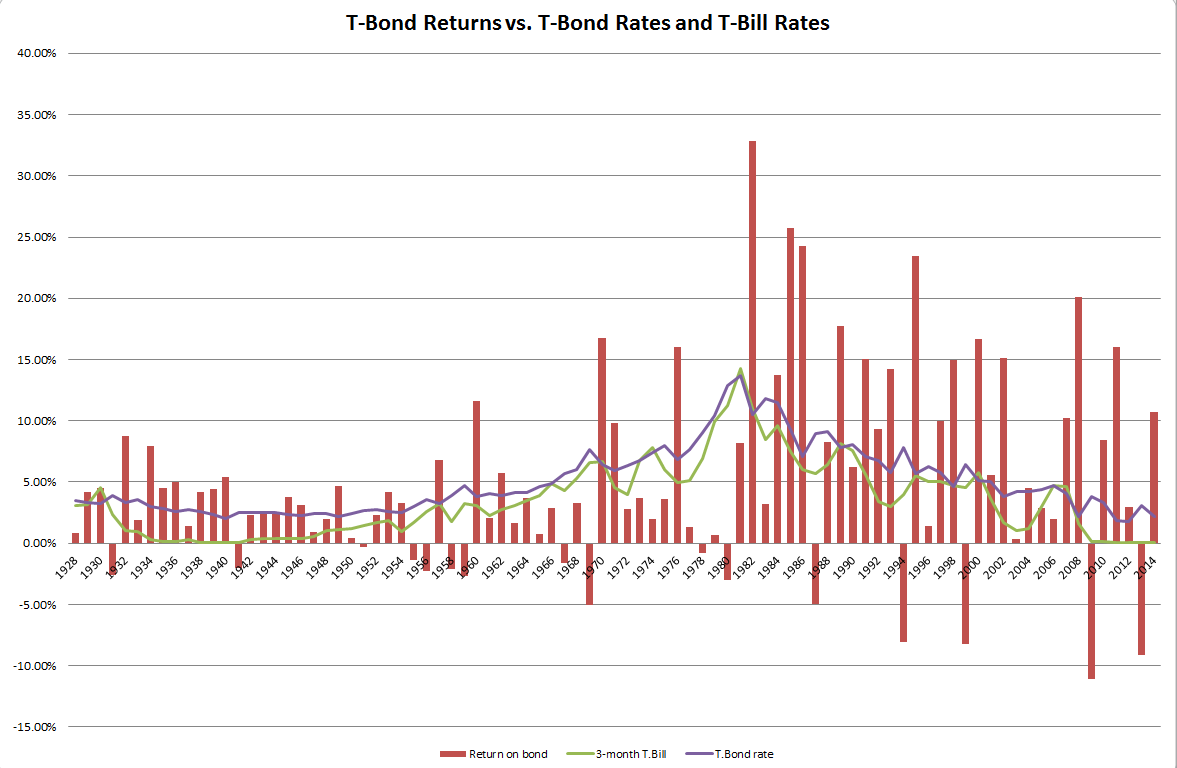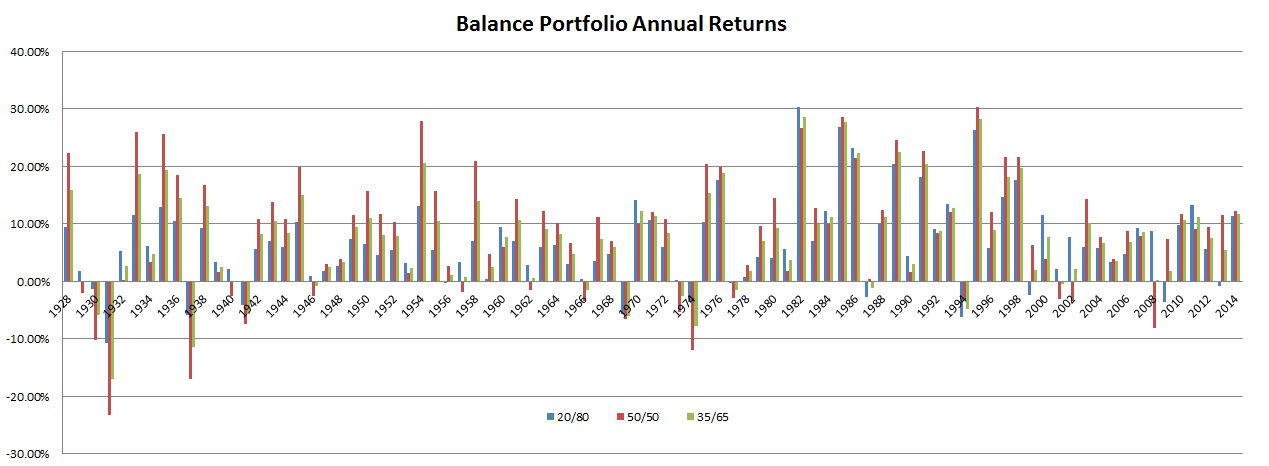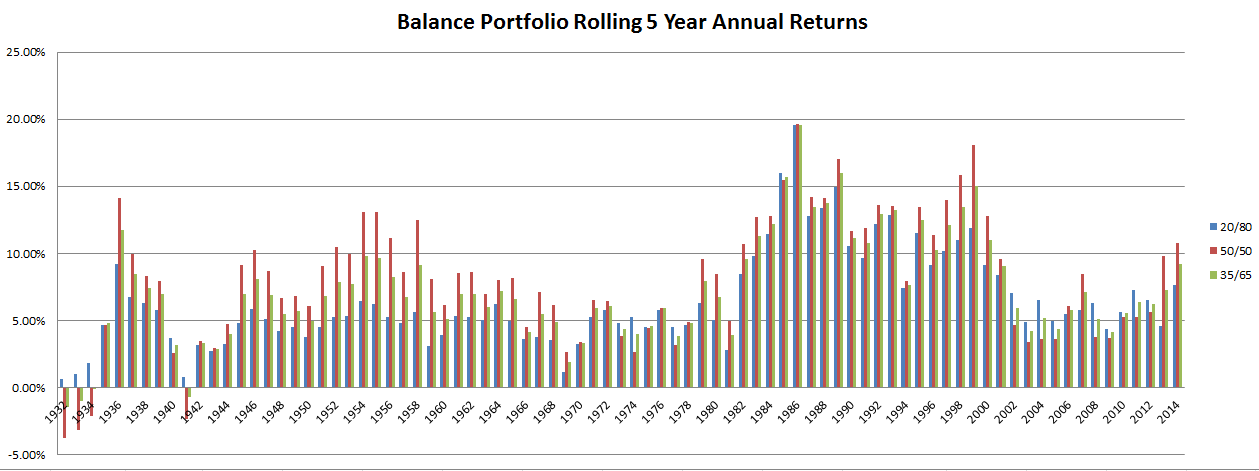Re-balance Cycle Reminder All MyPlanIQ’s newsletters are archived here.
For regular SAA and TAA portfolios, the next re-balance will be on Monday, May 18, 2015. You can also find the re-balance calendar for 2014 on ‘Dashboard‘ page once you log in.
As a reminder to expert users: advanced portfolios are still re-balanced based on their original re-balance schedules and they are not the same as those used in Strategic and Tactical Asset Allocation (SAA and TAA) portfolios of a plan.
Please note that we now list the next re-balance date on every portfolio page.
The Balanced Stock and Long Term Treasury Bond Portfolios
In this newsletter, we continue to explore the role of long term Treasury bonds in portfolio construction. In the previous newsletter April 27, 2015: Long Term Treasury Bond Behavior, we looked at the T-Bond behavior. From that, we see that T-Bond can be extremely volatile. Furthermore, it is worth to bring up the chart shown in that newsletter here again:
The key findings from the above chart are that T-Bond reached post Great Depression low in 1940 and started to rise in 1949 till 1981. Current situation is similar to either 1940 or 1949, depending on whether one thinks we are already at a rising rate environment or the current sub zero rate environment will last another 5-8 years (or less). Between 1940 and 1949, the interest rate has been kept steady. However, one should keep in mind that this period encompasses the World War II period and it is somewhat unusual in that sense.
We will focus on these two periods (1940-1981 and 1949-1981) and look at how a balance portfolio behaves.
Stock and Long Term Bond Balance Portfolios
It has been pointed out that 20%-30% stocks and 80%-70% bonds composition represents the ‘optimal’ portfolio composition that has the lowest volatility (or standard deviation). Technically, if one tries to optimize a portfolio by setting the optimal objective as lowest standard deviation, one would derive these types of portfolios (or ‘efficient frontier’ with respect to the lowest standard deviation).
It is important to remember that an all bond portfolio is NOT the ‘safest’. So, even if you are in retirement or ultra conservative, you should have some exposure to stocks.
Now let’s take a look at how several of these balance portfolios have fared for the past 80 so years. In addition to 20% stocks and 80% T-Bond portfolio, we also look at 50%/50% composition. Furthermore, we also look at the ‘combo’ portfolio that is the average of 20/80 and 50/50, or 35/65 portfolio.
Some stats:
| 20/80 | 50/50 | 35/65 | |
| number of negative years | 13 | 18 | 15 |
| biggest one year loss | -10.80% | -23.20% | -17.01% |
| biggest one year loss (since 1940) | -6.16% | -11.96% | -7.80% |
| annualized return (since 1928) | 6.28% | 7.88% | 7.13% |
But if we look at their 5 year rolling returns:
If we exclude years before 1941, all 3 portfolios have no negative 5 year rolling return. However, we should note that in 1941, both 50/50 and 35/65 had -7.4% and -5.78% annualized returns for its past 5 years, a pretty bad performance (i.e. every year, on average, a negative 5 or 7% return)!
Naturally, we are interested in how these portfolios performed during the long rising rate periods.
Rising rate periods
Since we are aware that for the last 30 plus years, bonds have been in a super bull cycle (i.e. a secular declining rate period). The annualized returns in the above table are somewhat skewed. The following table shows the portfolio performance in the two overlapped rising rate periods (from 1940-1981 or from 1949-1981):
| 20/80 AR | 50/50 AR | 35/65 AR | |
| From 1940-1981 | 4.53% | 6.96% | 5.77% |
| From 1949-1981 | 4.81% | 7.44% | 6.17% |
| From 1940-2014 | 6.28% | 7.88% | 7.13% |
What we can draw from the table:
- We prefer higher rising environment than a long period of low interest rate environment. From from 1940 to 1949 , interest rate was kept low but steady. This has hurt returns as since 1949, even though interest rates had risen dramatically, the returns were higher than that in 1940-1981, indicating the returns in 1940-1949 had a negative impact on the overall returns.
- In a rising rate environment, we prefer more exposure to stocks as 50/50 had better returns than 35/65 that was better than 20/80. In fact, this should be more so than in a normal environment: in a rising rate environment, 50/50 had more than 2.6% annual return than 20/80 while in the overall 1940-2014 period, the difference is 1.6%. This is also intuitive: bonds tend to be more troublesome in a rising rate period.
- Similarly, rising rate hurts the portfolios’ performance: the returns from 1940-1981 and 1949-1981 are all lower than those from 1940-2014. This again shows a possible difficult period ahead, just like what Bill Gross’ moaned about (see A sense of ending).
Put succinctly, a strategic portfolio should be slightly tilted to more stock exposure in a rising environment (but be extremely careful not to over exposed as stocks are actually more volatile and can incur much larger loss). However, in general, we are now entering a period of low returns everywhere (bonds and stocks). Thus, more exposure to active (tactical) allocation might be warranted.
The balanced static portfolios
We use both VFINX (Vanguard 500 Index Investor) (representing S&P 500) and VUSTX (Vanguard Long-Term Treasury Inv) to construct live static portfolios that are rebalanced annually. Here are the portfolio performance data:
Portfolio Performance Comparison (as of 5/1/2015):
| Ticker/Portfolio Name | YTD Return** |
1Yr AR | 3Yr AR | 5Yr AR | 10Yr AR | 10Yr Sharpe |
|---|---|---|---|---|---|---|
| 50 Stocks 50 Long Treasury Bonds | 1.1% | 13.4% | 11.1% | 12.2% | 8.7% | 0.9 |
| 35 Stocks 65 Long Treasury Bonds | 0.6% | 13.1% | 9.3% | 11.3% | 8.4% | 0.96 |
| 20 Stocks 80 Long Treasury Bonds | -0.0% | 12.9% | 7.3% | 10.3% | 7.8% | 0.78 |
Notice that 35/65 portfolio has the best 10 year Sharpe. In fact, for the past 25 plus years since 1989, it has had the best Sharpe ratio. Also, 35/65 has not had a single negative year since 2001. However, as what we discussed above, as a mega new trend (i.e. rising rate) is developing, we are increasingly more skeptical on using the past performance to extrapolate anything onward.
Market Overview
Long term bonds had a very bad week, so did the REITs. In fact, both long term bonds and REITs are showing trend scores that are close to negative. However, stocks (other than REITs) are in reasonably strong up trend. We have been in such a fragile recovery period for a long time while stocks have risen relentlessly. For now, the best way is to follow the trends.
For more detailed asset trend scores, please refer to 360° Market Overview.
We would like to remind our readers that markets are more precarious now than other times in the last 5 years. It is a good time and imperative to adjust to a risk level you are comfortable with right now. However, recognizing our deficiency to predict the markets, we will stay on course.
We again copy our position statements (from previous newsletters):
Our position has not changed: We still maintain our cautious attitude to the recent stock market strength. Again, we have not seen any meaningful or substantial structural change in the U.S., European and emerging market economies. However, we will let markets sort this out and will try to take advantage over its irrational behavior if it is possible.
We again would like to stress for any new investor and new money, the best way to step into this kind of markets is through dollar cost average (DCA), i.e. invest and/or follow a model portfolio in several phases (such as 2 or 3 months) instead of the whole sum at one shot.
Latest Articles
- April 27, 2015: Long Term Treasury Bond Behavior
- April 20, 2015: 529 College Savings Plan Rebalance Policy Change
- April 13, 2015: Total Return Bond Funds As Smart Cash
- April 6, 2015: The Low Return Environment
- March 30, 2015: Brokerage Specific Core Mutual Fund Portfolios 2
- March 23, 2015: Investment Arithmetic for Long Term Investments
- March 16, 2015: Brokerage Specific Core Mutual Fund Portfolios
- March 9, 2015: Newsletter Collection Update
- March 2, 2015: Total Return Bond ETFs
- February 23, 2015: Why Is Global Tactical Asset Allocation Not Popular?
- February 16, 2015: Where Are Permanent Portfolios Going?
- February 9, 2015: How Have Asset Allocation Funds Done?
- February 2, 2015: Risk Management Everywhere
- January 26, 2015: Composite Portfolios Review
- January 19, 2015: Fixed Income Investing Review
- January 12, 2015: How Does Trend Following Tactical Asset Allocation Strategy Deliver Returns
- January 5, 2015: When Forecast Fails
- December 22, 2014: Long Term Asset Returns: How Long Is Long?
- December 15, 2014: Beaten Down Assets
- December 8, 2014: Implementing Core Asset Portfolios In a Brokerage
- December 1, 2014: Two Key Issues of Investment Strategies
- November 24, 2014: Holiday Readings
- November 17, 2014: Retirement Spending Portfolios Update
- November 10, 2014: Fixed Income Or Cash
- November 3, 2014: Asset Trend Review
- October 27, 2014: Investment Loss, Mistakes And Market Cycles
- October 20, 2014: Strategic Portfolios With Managed Volatility
- October 13, 2014: Embrace Volatility
- October 6, 2014: Tips For 401k Open Enrollment
- September 29, 2014: What Can We Learn From Bill Gross’ Departure From PIMCO?
- September 22, 2014: Why Total Return Bond Funds?
- September 15, 2014: Equity And Total Return Bond Fund Composite Portfolios
- September 8, 2014: Momentum Based Portfolios Review
- September 1, 2014: Risk & Diversification: Mint.com Interview
- August 25, 2014: Remember Risk
- August 18, 2014: Consistency, The Most Important Edge In Investing: Tactical Case
- August 11, 2014: What To Do In Overvalued Stock Markets
- August 4, 2014: Is This The Peak Or Correction?
- July 28, 2014: Stock Musings
- July 21, 2014: Permanent Portfolios & Four Pillar Foundation Based Framework
- July 14, 2014: Composite Portfolios Review
- July 7, 2014: Portfolio Behavior During Market Corrections
- June 30, 2014: Half Year Brokerage ETF and Mutual Fund Portfolios Review
- June 23, 2014: Newsletter Collection Update
- June 16, 2014: There Are Always Lottery Winners
- June 9, 2014: The Arithmetic of Investment Mistakes
- June 2, 2014: Tips On Portfolio Rebalance
- May 26, 2014: In Praise Of Low Cost Core Asset Class Based Portfolios
- May 19, 2014: Consistency, The Most Important Edge In Investing: Strategic Case
- May 12, 2014: How To Handle An Elevated Overvalued Market
- May 5, 2014: Asset Allocation Funds Review
- April 28, 2014: Now The Economy Backs To The ‘Old Normal’, Should Our Investments Too?
- April 21, 2014: Total Return Bond Investing In The Current Market Environment
Enjoy Newsletter
How can we improve this newsletter? Please take our survey
–Thanks to those who have already contributed — we appreciate it.





 Diversified Asset Allocation Portfolios For Your Plans
Diversified Asset Allocation Portfolios For Your Plans
